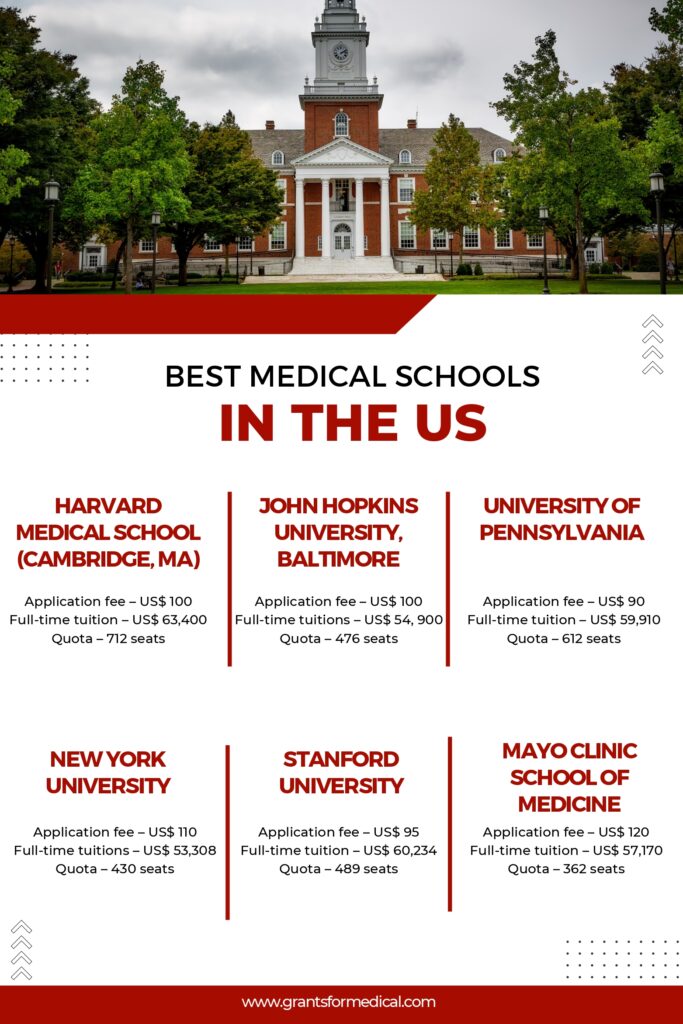Choosing the right medical school is a crucial decision for aspiring doctors, as it sets the foundation for their future career in healthcare. With numerous institutions to choose from, each offering unique programs and approaches, it can be a daunting task. However, by understanding the distinct structures and focuses of top medical schools in the United States, students can make an informed choice that aligns with their goals. In this article, we explore the curricula and specialties of renowned medical schools, as well as recent updates to the U.S. News rankings methodology. Read on to discover the top medical schools for research and primary care, and gain insights into what sets them apart.
Duke University
The medical program at Duke University follows a distinct structure compared to other institutions. Students are required to complete four years of education in the field of medicine. The curriculum at Duke University School of Medicine is organized as follows:
#1. 1st Year: Foundational Sciences
#2. 2nd Year: Clinical Rotations
#3. 3rd Year: Scholarly Research
#4. 4th Year: Clinical Electives
Those students who possess a creative mindset and aspire to become medical researchers have the opportunity to complete the program and join the team of clinical researchers promptly. Duke University is recognized globally as the largest academic organization for clinical research. Expert clinical researchers compose a team that investigates a wide range of subjects to advance the medical industry.
The research team at Duke University conducts trials spanning from phase I to phase IV for undisclosed diseases. The number of registered patients for research purposes exceeds 100,000. The research team easily carries out research and testing phases on these participants.
University of Washington School of Medicine
Established in 1946, the University of Washington School of Medicine serves as the primary medical facility provider in the five-state region encompassing Washington, Alaska, Idaho, Montana, and Wyoming.
Building a network to provide medical education across more than 100 cities in these five states is a core objective of these universities. The focus is on offering specialized education to a select number of students.
The curriculum for this network consists of three semesters per year. Students are required to complete three semesters each year to finish their medical education.
The primary aim of the university is to produce a greater number of doctors specializing in primary care across various medical centers in these states. The school has established a strong reputation for providing primary medical care to hundreds of students annually.
Yale School of Medicine
The Yale School of Medicine is another prestigious medical research institute in the United States. The university offers an extensive range of resources available to students through its library.
The School of Medicine's library is home to an abundance of resources, providing students with comprehensive education and information on a diverse range of subjects.
Originally established in 1810 as the Medical Institution of Yale College, the school adopted the name Yale School of Medicine in 1918. The school offers education in various medical fields, including biomedical science, medicine, and public health.
The education program at Yale University follows a unique structure. In the first two years of medical education, students are not given ranks or grades. Additionally, examinations are limited, allowing students the freedom to explore various subjects through research.
The standard medical course at Yale University spans four years. However, students are required to pay tuition fees for an additional year if they wish to pursue in-depth research.
The school also offers various other programs to medical students, enabling them to specialize in their field of interest.
University of Pittsburgh School of Medicine
The University of Pittsburgh School of Medicine provides a rapid medical education experience for students. From the very first year, the university offers students valuable clinical experiences.
The Physician Course at the University of Pittsburgh is unique in that students engage in interviewing patients in a community healthcare setting. This course also focuses on developing interpersonal and medical skills necessary for students to become competent physicians.
During the first and second years, students are allocated time to gain practical experience in medical facilities and hospitals. The completion of a longitudinal research project is a mandatory requirement for every student throughout their four-year medical degree.
The University places a strong emphasis on providing practical knowledge and skills rather than relying solely on written examinations. Their approach is to enable students to acquire extensive knowledge and experience in their chosen field.
Northwestern University Feinberg School of Medicine
Similar to the University of Pittsburgh School of Medicine, the first and second-year students at Northwestern University Feinberg School of Medicine are graded based solely on a pass or fail basis, without specific grades being assigned.
In contrast, third-year and fourth-year students receive grades ranging from fail, pass, high pass, to honor grades.
Students are encouraged to engage in extracurricular activities in diverse environments. Specifically, three afternoons per week are designated for such activities, allowing students to delve deeper into their subjects or partake in various research projects.
Due to this unique grading system, students experience less pressure and are able to focus more on their medical practice, ultimately becoming exceptional medical professionals capable of providing quality care to their patients without the need for high-ranking grades.
Icahn School of Medicine at Mount Sinai
Emory University
University of Chicago (Pritzker)
University of Michigan
Baylor College of Medicine
The Case Western Reserve University
University of North Carolina
The University of Texas Southwestern Medical Center
University of Colorado
University of Southern California
University of Maryland
Ohio State University
University of Virginia
Boston University
Oregon Health and Science University
Vanderbilt University School of Medicine (Nashville, TN)
Vanderbilt University, located in Nashville, Tennessee, is renowned for its sterling reputation. The university boasts a vast campus spanning 340 acres, making it the largest university in the state. With 10 schools catering to different areas of study, four of which offer undergraduate programs, Vanderbilt University stands out as an exceptional institution.
The School of Medicine at Vanderbilt University is affiliated with the Vanderbilt Health Affiliated Network, encompassing 60 hospitals and 5000 clinicians. As one of the largest academic medical centers in the United States, the university provides students with unparalleled opportunities for hands-on experience. Real-world patients and various medical departments offer practical lessons to students.
University of Nebraska Medical Center (Omaha, Nebraska)
Situated in Omaha, Nebraska, the University of Nebraska Medical Center is the largest medical center in the state. The university prides itself on inclusivity and welcomes students from all backgrounds, including international students who aspire to pursue careers in the medical field.
The campus is continuously expanding, with recent construction of a new building dedicated to engineering, information technology, and other disciplines, offering affordable education beyond the medical field.
With 19 different programs available, the University of Nebraska provides medical students with an array of options to choose from. These programs have granted a total of 391 doctorate degrees across various fields of medical science.
University of New Mexico School of Medicine (Albuquerque, New Mexico)
Since its establishment in 1964, the University of New Mexico School of Medicine has played a significant role in enhancing the healthcare infrastructure in New Mexico. As a result, the university has earned a well-deserved reputation as one of the top institutions in the medical field. The university places a particular emphasis on rural health training and family medicine.
The acceptance rate at the University of New Mexico is an impressive 97%, offering swift admission to prospective students. The university is committed to equal opportunities and welcomes students from both local and international backgrounds.
A wide range of degrees, including bachelor's, master's, and doctorate programs, are offered to assist students in pursuing their desired career paths. With over 40 different programs available, the University of New Mexico School of Medicine is an attractive choice for aspiring medical students.
University of Connecticut Medical School (Storrs, Connecticut)
The University of Connecticut operates a prestigious School of Medicine, which aims to provide accessible and cutting-edge education in the medical field. The university's mission revolves around innovation, education, discovery, and service, harnessing their expertise in various areas to help students build promising futures.
The university warmly welcomes international students and ensures equal facilities and education opportunities for all. Students can choose from a wide range of programs, including bachelor's, master's, and doctorate degrees, with a high acceptance rate. The University of Connecticut offers a total of 67 programs specifically tailored to medical students.
School of Medicine, University of Utah (Salt Lake City, Utah)
The School of Medicine at the University of Utah is situated on the upper side of the campus. Known for its impressive acceptance rate of 95%, it is one of the easiest universities in America to gain admission to. Furthermore, it holds the distinction of being the only MD-granting medical school in Utah.
With a diverse array of programs on offer, the University of Utah boasts one of the largest medical schools in the United States, offering a total of 64 programs. The school's statistics are highly commendable.
Indiana University School of Medicine (Indianapolis City, Indiana)
Indiana University School of Medicine is among the largest universities in the United States. With 20 clinical departments and five basic science departments, the medical school provides comprehensive education to medical students. The university is renowned for offering high-level education to individuals pursuing medical degrees.
The school has implemented an advanced education system that delves deep into various subjects. Moreover, the university strives to improve the healthcare environment of the country through modern curriculum activities.
Miller School of Medicine, University of Miami (Miami, Florida)
The Miller School of Medicine at the University of Miami is dedicated to producing skilled doctors capable of serving the global community. The school places equal emphasis on education, research, development, and science. Medical students are afforded an excellent environment to cultivate a bright future within the university.
The University of Miami warmly welcomes students from around the world who are eager to pursue medical degrees in various fields. The Miller School of Medicine offers a myriad of medical programs, allowing students to choose the one that suits their career goals.
UC Davis School of Medicine, University of California (Sacramento, California)
The UC Davis School of Medicine has garnered numerous accolades for its commitment to providing healthcare education. The school is ranked as the top university in the nation for primary care, underscoring its student-centric approach.
The school offers a variety of programs that produce skilled doctors and healthcare professionals. It is widely recognized as one of the premier institutions in the United States for offering quality education to medical students. In total, the School of Medicine provides 66 programs, allowing students to select their preferred path of study.
Carver College of Medicine, University of Iowa (Iowa City, Iowa)
The University of Iowa Healthcare operates the Carver College of Medicine, which offers medical education to students seeking a doctorate in the state of Iowa. The college has garnered recognition as one of the top medical schools according to U.S. News. The acceptance ratio of this college is truly impressive.
The University of Iowa Healthcare is dedicated to healthcare education, research, patient care, and the overall enhancement of the healthcare infrastructure. The university provides students from various fields with the opportunity to pursue bachelor's, master's, and doctorate degrees. A total of 86 programs are available to medical students.
College of Medicine, University of Arizona (Tucson, Arizona)
The University of Arizona College of Medicine delivers innovative undergraduate education to aspiring medical students. The university warmly welcomes students from across the globe who are devoted to building a future in the medical field. Students have the opportunity to participate in various research programs, gaining valuable practical experience within the university.
The university's acceptance rate, combined with hundreds of programs available for bachelor's, master's, and doctorate degrees, makes it an ideal destination for medical students seeking specialized education. The College of Medicine offers a staggering 89 doctorate programs, catering to specific requirements.
US News updates methodology after criticism
In January, prominent medical schools, including Harvard University, Columbia University, the University of Pennsylvania, the Icahn School of Medicine at Mount Sinai, and Stanford University, announced their withdrawal from U.S. News' annual rankings. This followed a similar decision made by law schools the previous year.
According to Katrina Armstrong, the dean of Columbia's Valegos College of Physicians and Surgeons, the medical school rankings perpetuate a narrow and elitist perspective on medical education. Armstrong accentuates that these rankings place excessive emphasis on self-reinforcing criteria such as reputation and institutional wealth, rather than measuring a school's success in producing a diverse and well-trained cohort of doctors capable of driving positive change in the field of medicine and meeting the needs of society.
As a response to the criticism received, U.S. News has introduced new methodology for this year's medical school rankings. The revised approach includes an evaluation of faculty resources, academic achievements of incoming students, and research productivity. Even though schools that chose not to participate in the rankings did not provide data to the organization, publicly available information was utilized to fill in any gaps.
Methodology for the research rankings
U.S. News analyzed the performance of each medical school for the research rankings by considering a weighted average of the following indicators:
- Research activity: This encompasses total federal research activity, total research activity per faculty member, total NIH research grants obtained by the school and its affiliated hospitals, and average NIH research grants received per faculty member. The latter two categories are new additions to this year's rankings, and they contribute 45% to a school's rank.
- Qualitative assessment: This involves a peer assessment score provided by deans of medical schools and deans of academic affairs, alongside a residency directors assessment score. Together, these factors account for 12.5% of a school's rank, compared to the 15% weight they held in the previous year.
- Student selectivity: This takes into account the median MCAT score, median undergraduate GPA, and acceptance rate. It contributes 15% to a school's rank, a reduction from the 20% weight assigned in the previous year.
- Faculty resources: This measures the ratio of full-time faculty to full-time MD or DO students in 2022. It now constitutes 15% of a school's rank, an increase from the 10% weightage assigned in the previous year.
The top 10 medical schools for research
According to U.S. News, the top 10 medical schools for research, including ties, are:
1. Harvard University*
2. Johns Hopkins University
3. University of Pennsylvania*
4. Columbia University*
5. Duke University*
5. Stanford University*
5. University of California, San Francisco
5. Vanderbilt University
5. Washington University in St. Louis*
10. Cornell University*
10. New York University
10. Yale University
*Signifies that the school did not participate in U.S. News' statistical survey for this year's rankings, and data from the previous year was utilized instead.
Methodology for the primary care rankings
For the primary care rankings, U.S. News assessed each medical school's performance based on a weighted average of the following indicators:
- Primary care productivity: This encompasses the number of medical school graduates practicing in primary care specialties and the percentage of graduates entering primary care residencies. It contributes 50% to a school's rank, an increase from the 40% weight it held in the previous year.
- Qualitative assessment: This includes a peer assessment score provided by deans of medical schools and deans of academic affairs, alongside a residency directors assessment score. Together, these factors account for 12.5% of a school's rank, compared to the 15% weight they held in the previous year.
- Student selectivity: This takes into account the median MCAT score, median undergraduate GPA, and acceptance rate. It contributes 15% to a school's rank, with some alterations in weighting for each category compared to the previous year.
- Faculty resources: This measures the ratio of full-time faculty to full-time MD or DO students in 2022. It now constitutes 10% of a school's rank, a decrease from the 15% weightage assigned in the previous year.
The top 10 medical schools for primary care
The top 10 medical schools for primary care, including ties, are:
1. Washington University
2. University of Minnesota
3. Oregon Health and Science University
4. University of New Mexico
5. University of California, San Francisco
6. University of California, Davis
7. University of North Carolina, Chapel Hill
8. University of Colorado
8. University of Nebraska Medical Center
10. University of California, Los Angeles
What distinguishes primary care and research medical schools?
The traditional model of medical schools solely training physicians for research pursuits is now outdated. Present-day medical schools offer multifaceted degree and program options. As demonstrated by this ranking, schools equip students to become primary care physicians, while also expanding the MD framework to include additional qualifications such as a PhD or Masters in complementary fields like business administration (MD/MBA), law (MD/JD), or pursuit of physician-scientist training (MSTP), among others. Some medical schools also encompass public health, nursing, physician assistant, and other health professions within their educational scope.
Most medical schools provide education for primary care physicians and offer opportunities for scientific research endeavors. It may be more competitive to gain admission to a research-focused medical school. However, if you possess a profound scientific interest in cutting-edge medicine, technology, or development, you may prefer a top-tier medical school with a robust research program.
Research-focused schools typically receive substantial external funding for their programs, as observed in this medical school ranking.
Which factors contribute to higher rankings for medical schools?
U.S. News and World Report, one of the most prominent ranking services, examines various factors in their program surveys, relying in part on self-reported data from the schools. These factors include quality and peer assessments, student admission standards, acceptance rates, average GPA and MCAT scores, faculty qualifications and resources, tuition costs, graduation rates, and faculty achievements in research. Research-intensive medical schools are evaluated based on funding levels and faculty accomplishments, as well as ongoing studies.

Increasingly, diversity and inclusion rates are considered in the overall ranking of medical schools. Race and gender have become important factors in a school's ranking as institutions strive to include a student body that is more representative of the nation's population.
In a constantly evolving field like medicine, choosing the right medical school is a crucial step towards a successful career. With diverse programs, exceptional faculty, and groundbreaking research, these top-ranked institutions provide students with the tools they need to become outstanding healthcare professionals. Whether your passion lies in primary care or cutting-edge research, these schools offer unparalleled opportunities to shape the future of medicine. So, embark on your journey to medical excellence and explore the endless possibilities waiting for you at these esteemed institutions.





